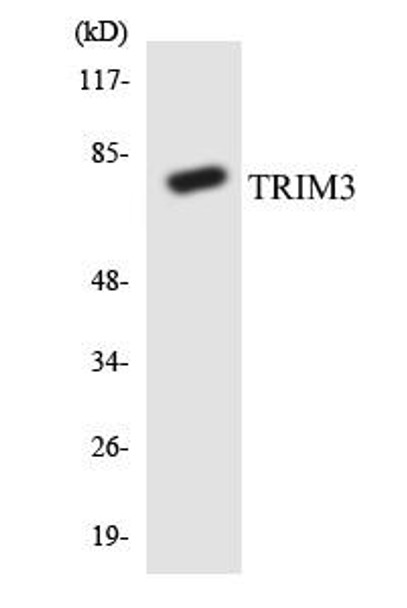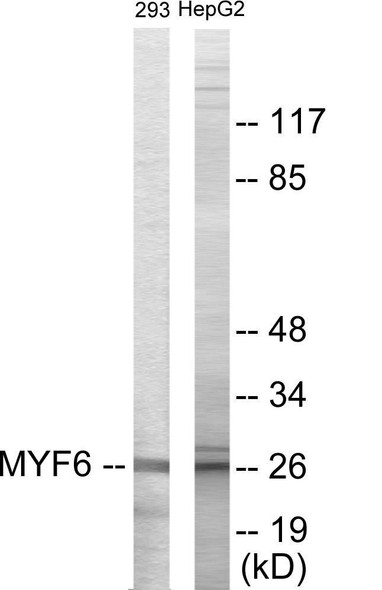Description
TRIM3 Colorimetric Cell-Based ELISA
The TRIM3 Colorimetric Cell-Based ELISA Kit is a powerful tool for studying Trim3 protein levels in a variety of cell types. This kit offers high sensitivity and specificity, allowing for accurate and reproducible results in your research.Trim3 is a key protein involved in cellular processes such as protein degradation and immune response regulation. Dysregulation of Trim3 has been implicated in various diseases, including cancer, neurodegenerative disorders, and autoimmune conditions, making it a valuable biomarker for studying these conditions and exploring potential therapeutic interventions.
With the TRIM3 Colorimetric Cell-Based ELISA Kit, researchers can easily measure Trim3 levels in cell lysates or tissue samples, facilitating a deeper understanding of disease mechanisms and potential treatment strategies. Trust in this kit for reliable and precise data in your research endeavors. Visit www.assaygenie.com/trim3-colorimetric-cell-based-elisa/ to learn more and order your kit today.
| Product Name: | TRIM3 Colorimetric Cell-Based ELISA |
| Product Code: | CBCAB00948 |
| ELISA Type: | Cell-Based |
| Target: | TRIM3 |
| Reactivity: | Human, Mouse, Rat |
| Dynamic Range: | > 5000 Cells |
| Detection Method: | Colorimetric 450 nmStorage/Stability:4°C/6 Months |
| Format: | 96-Well Microplate |
The TRIM3 Colorimetric Cell-Based ELISA Kit is a convenient, lysate-free, high throughput and sensitive assay kit that can detect TRIM3 protein expression profile in cells. The kit can be used for measuring the relative amounts of TRIM3 in cultured cells as well as screening for the effects that various treatments, inhibitors (ie siRNA or chemicals), or activators have on TRIM3.
Qualitative determination of TRIM3 concentration is achieved by an indirect ELISA format. In essence, TRIM3 is captured by TRIM3-specific primary antibodies while the HRP-conjugated secondary antibodies bind the Fc region of the primary antibody. Through this binding, the HRP enzyme conjugated to the secondary antibody can catalyze a colorimetric reaction upon substrate addition. Due to the qualitative nature of the Cell-Based ELISA, multiple normalization methods are needed:
| 1. | A monoclonal antibody specific for human GAPDH is included to serve as an internal positive control in normalizing the target absorbance values. |
| 2. | Following the colorimetric measurement of HRP activity via substrate addition, the Crystal Violet whole-cell staining method may be used to determine cell density. After staining, the results can be analysed by normalizing the absorbance values to cell amounts, by which the plating difference can be adjusted. |
| Database Information: | Gene ID: 10612, UniProt ID: O75382, OMIM: 605493, Unigene: Hs.591992 |
| Gene Symbol: | TRIM3 |
| Sub Type: | None |
| UniProt Protein Function: | TRIM3: Probably involved in vesicular trafficking via its association with the CART complex. The CART complex is necessary for efficient transferrin receptor recycling but not for EGFR degradation. Belongs to the TRIM/RBCC family. 3 isoforms of the human protein are produced by alternative splicing. |
| UniProt Protein Details: | Protein type:Cytoskeletal; Ubiquitin conjugating system Chromosomal Location of Human Ortholog: 11p15.5 Cellular Component: cytoplasm; early endosome Molecular Function:protein C-terminus binding; protein binding; zinc ion binding; ubiquitin-protein ligase activity Biological Process: nervous system development; protein transport; protein ubiquitination |
| NCBI Summary: | The protein encoded by this gene is a member of the tripartite motif (TRIM) family, also called the 'RING-B-box-coiled-coil' (RBCC) subgroup of RING finger proteins. The TRIM motif includes three zinc-binding domains, a RING, a B-box type 1 and a B-box type 2, and a coiled-coil region. This protein localizes to cytoplasmic filaments. It is similar to a rat protein which is a specific partner for the tail domain of myosin V, a class of myosins which are involved in the targeted transport of organelles. The rat protein can also interact with alpha-actinin-4. Thus it is suggested that this human protein may play a role in myosin V-mediated cargo transport. Alternatively spliced transcript variants encoding the same isoform have been identified. [provided by RefSeq, Jul 2008] |
| UniProt Code: | O75382 |
| NCBI GenInfo Identifier: | 351721563 |
| NCBI Gene ID: | 10612 |
| NCBI Accession: | NP_001234935.1 |
| UniProt Secondary Accession: | O75382,Q4V9L4, Q9C038, Q9C039, B7Z5E6, F5H2Q8, |
| UniProt Related Accession: | O75382 |
| Molecular Weight: | 80,830 Da |
| NCBI Full Name: | tripartite motif-containing protein 3 isoform 1 |
| NCBI Synonym Full Names: | tripartite motif containing 3 |
| NCBI Official Symbol: | TRIM3 |
| NCBI Official Synonym Symbols: | BERP; HAC1; RNF22; RNF97 |
| NCBI Protein Information: | tripartite motif-containing protein 3; RING finger protein 97; ring finger protein 22; brain expressed ring finger; tripartite motif-containing 3; tripartite motif protein TRIM3; brain-expressed RING finger protein |
| UniProt Protein Name: | Tripartite motif-containing protein 3 |
| UniProt Synonym Protein Names: | Brain-expressed RING finger protein; RING finger protein 22; RING finger protein 97 |
| Protein Family: | Tripartite motif-containing protein |
| UniProt Gene Name: | TRIM3 |
| UniProt Entry Name: | TRIM3_HUMAN |
| Component | Quantity |
| 96-Well Cell Culture Clear-Bottom Microplate | 2 plates |
| 10X TBS | 24 mL |
| Quenching Buffer | 24 mL |
| Blocking Buffer | 50 mL |
| 15X Wash Buffer | 50 mL |
| Primary Antibody Diluent | 12 mL |
| 100x Anti-Phospho Target Antibody | 60 µL |
| 100x Anti-Target Antibody | 60 µL |
| Anti-GAPDH Antibody | 60 µL |
| HRP-Conjugated Anti-Rabbit IgG Antibody | 12 mL |
| HRP-Conjugated Anti-Mouse IgG Antibody | 12 mL |
| SDS Solution | 12 mL |
| Stop Solution | 24 mL |
| Ready-to-Use Substrate | 12 mL |
| Crystal Violet Solution | 12 mL |
| Adhesive Plate Seals | 2 seals |
The following materials and/or equipment are NOT provided in this kit but are necessary to successfully conduct the experiment:
- Microplate reader able to measure absorbance at 450 nm and/or 595 nm for Crystal Violet Cell Staining (Optional)
- Micropipettes with capability of measuring volumes ranging from 1 µL to 1 ml
- 37% formaldehyde (Sigma Cat# F-8775) or formaldehyde from other sources
- Squirt bottle, manifold dispenser, multichannel pipette reservoir or automated microplate washer
- Graph paper or computer software capable of generating or displaying logarithmic functions
- Absorbent papers or vacuum aspirator
- Test tubes or microfuge tubes capable of storing ≥1 ml
- Poly-L-Lysine (Sigma Cat# P4832 for suspension cells)
- Orbital shaker (optional)
- Deionized or sterile water
*Note: Protocols are specific to each batch/lot. For the correct instructions please follow the protocol included in your kit.
| Step | Procedure |
| 1. | Seed 200 µL of 20,000 adherent cells in culture medium in each well of a 96-well plate. The plates included in the kit are sterile and treated for cell culture. For suspension cells and loosely attached cells, coat the plates with 100 µL of 10 µg/ml Poly-L-Lysine (not included) to each well of a 96-well plate for 30 minutes at 37°C prior to adding cells. |
| 2. | Incubate the cells for overnight at 37°C, 5% CO2. |
| 3. | Treat the cells as desired. |
| 4. | Remove the cell culture medium and rinse with 200 µL of 1x TBS, twice. |
| 5. | Fix the cells by incubating with 100 µL of Fixing Solution for 20 minutes at room temperature. The 4% formaldehyde is used for adherent cells and 8% formaldehyde is used for suspension cells and loosely attached cells. |
| 6. | Remove the Fixing Solution and wash the plate 3 times with 200 µL 1x Wash Buffer for five minutes each time with gentle shaking on the orbital shaker. The plate can be stored at 4°C for a week. |
| 7. | Add 100 µL of Quenching Buffer and incubate for 20 minutes at room temperature. |
| 8. | Wash the plate 3 times with 1x Wash Buffer for 5 minutes each time. |
| 9. | Add 200 µL of Blocking Buffer and incubate for 1 hour at room temperature. |
| 10. | Wash 3 times with 200 µL of 1x Wash Buffer for 5 minutes each time. |
| 11. | Add 50 µL of 1x primary antibodies (Anti-TRIM3 Antibody and/or Anti-GAPDH Antibody) to the corresponding wells, cover with Parafilm and incubate for 16 hours (overnight) at 4°C. If the target expression is known to be high, incubate for 2 hours at room temperature. |
| 12. | Wash 3 times with 200 µL of 1x Wash Buffer for 5 minutes each time. |
| 13. | Add 50 µL of 1x secondary antibodies (HRP-Conjugated AntiRabbit IgG Antibody or HRP-Conjugated Anti-Mouse IgG Antibody) to corresponding wells and incubate for 1.5 hours at room temperature. |
| 14. | Wash 3 times with 200 µL of 1x Wash Buffer for 5 minutes each time. |
| 15. | Add 50 µL of Ready-to-Use Substrate to each well and incubate for 30 minutes at room temperature in the dark. |
| 16. | Add 50 µL of Stop Solution to each well and read OD at 450 nm immediately using the microplate reader. |
(Additional Crystal Violet staining may be performed if desired – details of this may be found in the kit technical manual.)






